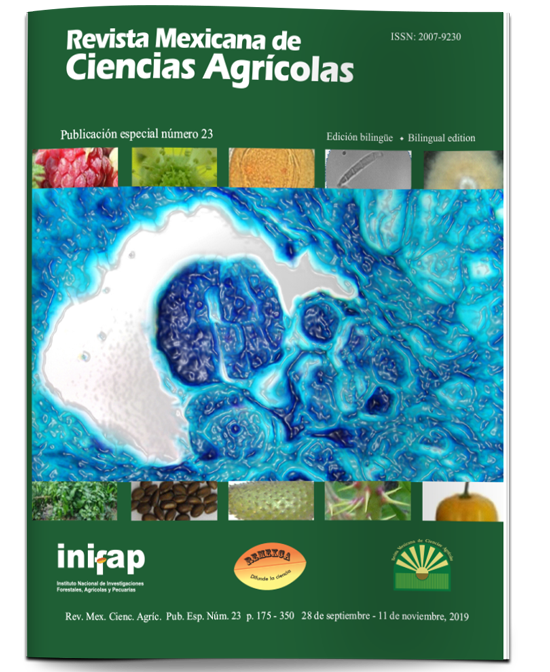Temperature and floral development in the formation of parthenocarpic fruits in mango ‘Ataulfo’
DOI:
https://doi.org/10.29312/remexca.v0i23.2021Keywords:
Mangifera indica L., development of embryo, fruits without seed, inflorescence, mooring of fruitsAbstract
One of the main problems in mango ‘Ataulfo’ is the so-called ‘mango child’ to refer to the high production of parthenocarpic fruits. The objective was to determine the factors of the climate that affect the presence of parthenocarpic fruits and in which part of the development of the inflorescence and fruit are affecting. The study was carried out from 2017 to 2018 in a commercial orchard of mango ‘Ataulfo’, with an incidence of 80% of parthenocarpic fruits, 10 trees were selected and in each tree 50 inflorescences were marked, in each flow of flowering presented, which they were distributed around the tree and in the middle part of the treetop. The variables evaluated were the development of the inflorescence, percentage and type of fruits (parthenocarpic and with seed), embryo development and temperature. Two flowering flows were presented. The second flowering period lasted for a period slightly longer than 70 days and the stage of full flowering until fruit set coincided with extreme temperatures, minimum of 15 °C on average and maximum above 35. The highest production of parthenocarpic fruit was presented in the second flowering flow with 75%, while in the first the production of fruits with seed exceeded the parthenocarpic. In Nayarit, the presence of parthenocarpic fruits is related to extreme temperatures (≤15 and ≥35 °C) during the period of full flowering until fruit mooring, causing embryo abortion.
Downloads
Downloads
Published
How to Cite
Issue
Section
License
The authors who publish in Revista Mexicana de Ciencias Agrícolas accept the following conditions:
In accordance with copyright laws, Revista Mexicana de Ciencias Agrícolas recognizes and respects the authors’ moral right and ownership of property rights which will be transferred to the journal for dissemination in open access. Invariably, all the authors have to sign a letter of transfer of property rights and of originality of the article to Instituto Nacional de Investigaciones Forestales, Agrícolas y Pecuarias (INIFAP) [National Institute of Forestry, Agricultural and Livestock Research]. The author(s) must pay a fee for the reception of articles before proceeding to editorial review.
All the texts published by Revista Mexicana de Ciencias Agrícolas —with no exception— are distributed under a Creative Commons License Attribution-NonCommercial 4.0 International (CC BY-NC 4.0), which allows third parties to use the publication as long as the work’s authorship and its first publication in this journal are mentioned.
The author(s) can enter into independent and additional contractual agreements for the nonexclusive distribution of the version of the article published in Revista Mexicana de Ciencias Agrícolas (for example include it into an institutional repository or publish it in a book) as long as it is clearly and explicitly indicated that the work was published for the first time in Revista Mexicana de Ciencias Agrícolas.
For all the above, the authors shall send the Letter-transfer of Property Rights for the first publication duly filled in and signed by the author(s). This form must be sent as a PDF file to: revista_atm@yahoo.com.mx; cienciasagricola@inifap.gob.mx; remexca2017@gmail.
This work is licensed under a Creative Commons Attribution-Noncommercial 4.0 International license.



